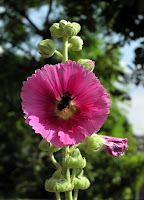
I only came back from a fantastic holiday a few weeks ago, on the Isle of Islay in Scotland, but I'm ready for another break already.
Britain has plenty to offer a witch wanting to escape the city for a week or so - sacred sites such as Glastonbury or Avebury, tranquil countryside in which to get in touch with nature and beautiful beaches to relax on in a deckchair while reading something like
Dion Fortune's The Sea Priestess.
It isn't difficult to simply decide where you want to go, get some accommodation details from the local tourist information centre and book up a holiday for yourself.
But if you are a solitary witch and your friends or partner aren't into pagan stuff, you may have a lonely holiday or just go along with what your family wants and end up at a theme park in worship of a millionaire mouse.
Witches who belong to covens or other pagan groups often hear about witch camps they can go along to. These are often organised on a not-for-profit basis so they are cheap and the accommodation is basic, but you know you will spend the week taking part in outdoor rituals and practising your craft with fellow spirits.
One of the best holidays I ever had, back when I was a young witch, was at a witch camp in a forest. It was glorious to wake up to dappled sunlight through the trees, to meditate in glades smelling of pine with only the sound of birdsong as a distraction, and in the evening to dance around the fire to shamanic drumming.
Now I am older, and maybe wiser, I remember other things: wading through muddy fields in wellies, trying to find a piece of ground without stones on which to pitch my tent, a diet of veggie slops and burnt offerings, and tripping over tree roots while trying to find the portaloo in the dark.
These days I am not so sure discomfort is an essential part of spirituality. When I'm on holiday, I want a proper bed, an en suite bathroom and a menu to choose from at mealtimes.
It seems that I'm not alone. More and more travel companies are offering holistic holidays, spiritual spas, relaxing retreats and all kinds of magical mystery tours. To find exactly the kind of thing you are looking for, at the right price, you might want to talk to an agency that specialises in them.
One I would recommend is Neal's Yard Holidays. It was established in 1991 and claims to be the original specialist in holistic holidays and events. Its website
http://www.nealsyardagency.com/ lists a large number of spiritual holidays, shamanic retreats, wildlife holidays, green courses, tipi camps and more in the UK and abroad. The telephone number is 0844 888 5050 if you want to chat to a member of staff about the options.
Something that tempted me at the other end of the scale is The Witchery by the Castle, in Edinburgh. This luxury restaurant is famous for its superb food, celebrity clientele and Gothic decor. And for a night of magical decadence, you could try to book one of the Witchery Suites, next door to The Witchery by the Castle.
These seven sinful suites are called the Library, Vestry, Inner Sanctum, Old Rectory, Sempill, Guardroom and Armoury. They offer wall-to-wall decadence, antiques, Gothic decor and roll-top baths big enough for two. The rates, including continental breakfast, vat, newspapers and a complimentary bottle of Champagne are from £295 per suite per night. Perhaps I should try to bewitch someone with enough money to treat me!
For information, visit
www.thewitchery.com/home.htmlLinks:
http://www.nealsyardagency.com/www.thewitchery.com/home.htmlwww.luxuryedinburgh.com/witchery-by-the-castle.html&pic=1
 A good way to celebrate the start of the harvest at Lammas, or Lughnasad, is to bake your own bread.
A good way to celebrate the start of the harvest at Lammas, or Lughnasad, is to bake your own bread.



















